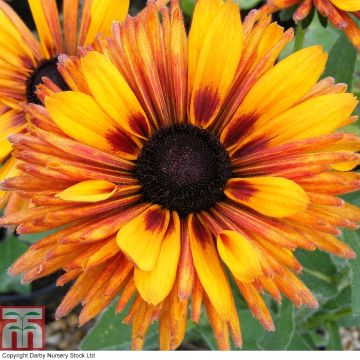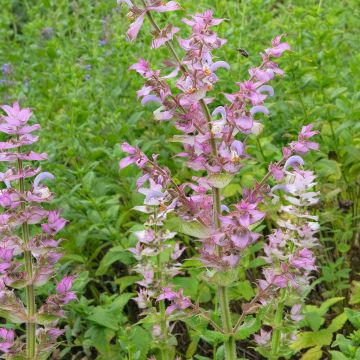

Graines de Rudbeckia Caramel mixed en mélange.
Rudbeckia hirta Caramel mixed
Rudbeckia x hirta Caramel mixed
Black-eyed Susan, Gloriosa Daisy
Special offer!
Receive a €20 voucher for any order over €90 (excluding delivery costs, credit notes, and plastic-free options)!
1- Add your favorite plants to your cart.
2- Once you have reached €90, confirm your order (you can even choose the delivery date!).
3- As soon as your order is shipped, you will receive an email containing your voucher code, valid for 3 months (90 days).
Your voucher is unique and can only be used once, for any order with a minimum value of €20, excluding delivery costs.
Can be combined with other current offers, non-divisible and non-refundable.
Home or relay delivery (depending on size and destination)
Schedule delivery date,
and select date in basket
This plant carries a 6 months recovery warranty
More information
We guarantee the quality of our plants for a full growing cycle, and will replace at our expense any plant that fails to recover under normal climatic and planting conditions.
Would this plant suit my garden?
Set up your Plantfit profile →
Description
The Rudbeckia x hirta 'Caramel Mixed' is a mix of rudbeckias shaded in unusual colours, in tones of amber, copper, and burnt rose, with the colour combination constantly changing depending on the plants. These short-lived perennials created by Thompson & Morgan are part of a new generation of hybrids that bloom from July on compact plants with sturdy stems. Their double daisy-like inflorescences continually renew until October, unaffected by heat and poor soils. They thrive in borders, both in sunny and semi-shaded spots, and are perfect for container gardening.
The Rudbeckia (x) hirta Caramel Mixed is a recent selection of plants resulting from, among others, the Rudbeckia hirta, a wild species from the aster family native to North American prairies. It is a short-lived perennial often grown as an annual or biennial plant. In the garden, it usually lasts no more than 2 to 3 years, but it readily self-seeds. These hybrids, shorter than their ancestor, reach a height of 50 cm (20in) and spread about 30 cm (12in). This cultivar also stands out for its early flowering and the sensational colours of its flowers, which vary like those found in the countryside.
The inflorescences are large solitary daisies (heads) with a diameter of 7 to 10 cm (3 to 4in), centred around a prominent blackish-violet cone. From July to October, numerous flowers succeed each other on the plant, forming an impressive mass. At the end of summer, the petals fade and fall, while the centre of the flowers dries and becomes papery. The flowers can then be picked and incorporated into a dried bouquet. The foliage consists of a tuft of lanceolate, dentate, dark green leaves measuring 5 to 10 cm (2 to 4in) from which robust and branched floral stems emerge. The stems bear narrower cauline leaves that are somewhat oval.
The compact shape of the 'Caramel Mixed' Rudbeckias allows them to be used in perennial borders, edging, and large flowering pots. They can be combined with other varieties or accompanied by inulas, asters, yarrows, shrubby salvias, echinops, and phlox. Lighten the scene by mixing ornamental grasses such as Stipa tenuifolia and Muhlenbergia capillaris... Add the blue colour lacking by sowing, for example, perennial flax or powder blue Ageratum between their feet against a backdrop of Caryopteris. Splendid in borders, their astonishing colours are also beautiful in fresh or dried flower arrangements from summer to autumn. Hardy, the mixed caramel rudbeckia thrives in sunny or semi-shaded locations and is not picky about soil; it is a particularly heat-resistant variety that tolerates dry and poor soils.
An ecological asset: Throughout the summer, the nectar-rich flowers of Rudbeckias attract pollinating insects and butterflies to your garden.An excellent way to improve the ecosystem and promote fruit and vegetable production in your vegetable garden. In autumn, you can admire the constant ballet of birds feeding on mature seeds found in the dried flower heads.
Report an error about the product description
Flowering
Foliage
Plant habit
Botanical data
Rudbeckia
x hirta
Caramel mixed
Asteraceae
Black-eyed Susan, Gloriosa Daisy
Cultivar or hybrid
Other Rudbeckia seeds
View all →Planting and care
Before sowing the Rudbeckia, place your seeds in the vegetable drawer of your refrigerator for 4 weeks. This will help break the seed dormancy and improve the success of your sowing.
Sow Rudbeckia Cherry Brandy from February to April in a seed tray. Use good quality compost that you sieve over the surface to ensure good contact between the seed and the substrate. Before sowing, gently firm down the compost with a board. Scatter your seeds evenly. Cover the seeds by sprinkling compost or vermiculite on top, lightly firming it down, and water generously with a fine mist. Place your seed tray in a well-lit area, away from direct sunlight, at a temperature of 20°C (68°F) to 25°C (77°F). Lower the temperature at night to around 18°C (64.4°F) to create beneficial germination conditions.
The seeds will take 10 to 21 days to germinate. Once the seedlings are large enough to handle, transplant them into 7cm (3in) pots. Keep the compost moist but not waterlogged during the growing period. About 15 days before planting them in their final position, start gradually acclimatizing them to a temperature of 15°C (59°F).
By the end of May or early June, the temperature in the garden will be warm enough to plant your young plants. Choose a sunny location. Add a generous handful of compost to each planting hole. Space your plants 30cm (12in) apart.
Regularly remove faded flowers to maintain the beauty of the plant and encourage new blooms.
Sowing period
Intended location
This item has not been reviewed yet - be the first to leave a review about it.
Similar products
Haven't found what you were looking for?
Hardiness is the lowest winter temperature a plant can endure without suffering serious damage or even dying. However, hardiness is affected by location (a sheltered area, such as a patio), protection (winter cover) and soil type (hardiness is improved by well-drained soil).

Photo Sharing Terms & Conditions
In order to encourage gardeners to interact and share their experiences, Promesse de fleurs offers various media enabling content to be uploaded onto its Site - in particular via the ‘Photo sharing’ module.
The User agrees to refrain from:
- Posting any content that is illegal, prejudicial, insulting, racist, inciteful to hatred, revisionist, contrary to public decency, that infringes on privacy or on the privacy rights of third parties, in particular the publicity rights of persons and goods, intellectual property rights, or the right to privacy.
- Submitting content on behalf of a third party;
- Impersonate the identity of a third party and/or publish any personal information about a third party;
In general, the User undertakes to refrain from any unethical behaviour.
All Content (in particular text, comments, files, images, photos, videos, creative works, etc.), which may be subject to property or intellectual property rights, image or other private rights, shall remain the property of the User, subject to the limited rights granted by the terms of the licence granted by Promesse de fleurs as stated below. Users are at liberty to publish or not to publish such Content on the Site, notably via the ‘Photo Sharing’ facility, and accept that this Content shall be made public and freely accessible, notably on the Internet.
Users further acknowledge, undertake to have ,and guarantee that they hold all necessary rights and permissions to publish such material on the Site, in particular with regard to the legislation in force pertaining to any privacy, property, intellectual property, image, or contractual rights, or rights of any other nature. By publishing such Content on the Site, Users acknowledge accepting full liability as publishers of the Content within the meaning of the law, and grant Promesse de fleurs, free of charge, an inclusive, worldwide licence for the said Content for the entire duration of its publication, including all reproduction, representation, up/downloading, displaying, performing, transmission, and storage rights.
Users also grant permission for their name to be linked to the Content and accept that this link may not always be made available.
By engaging in posting material, Users consent to their Content becoming automatically accessible on the Internet, in particular on other sites and/or blogs and/or web pages of the Promesse de fleurs site, including in particular social pages and the Promesse de fleurs catalogue.
Users may secure the removal of entrusted content free of charge by issuing a simple request via our contact form.
The flowering period indicated on our website applies to countries and regions located in USDA zone 8 (France, the United Kingdom, Ireland, the Netherlands, etc.)
It will vary according to where you live:
- In zones 9 to 10 (Italy, Spain, Greece, etc.), flowering will occur about 2 to 4 weeks earlier.
- In zones 6 to 7 (Germany, Poland, Slovenia, and lower mountainous regions), flowering will be delayed by 2 to 3 weeks.
- In zone 5 (Central Europe, Scandinavia), blooming will be delayed by 3 to 5 weeks.
In temperate climates, pruning of spring-flowering shrubs (forsythia, spireas, etc.) should be done just after flowering.
Pruning of summer-flowering shrubs (Indian Lilac, Perovskia, etc.) can be done in winter or spring.
In cold regions as well as with frost-sensitive plants, avoid pruning too early when severe frosts may still occur.
The planting period indicated on our website applies to countries and regions located in USDA zone 8 (France, United Kingdom, Ireland, Netherlands).
It will vary according to where you live:
- In Mediterranean zones (Marseille, Madrid, Milan, etc.), autumn and winter are the best planting periods.
- In continental zones (Strasbourg, Munich, Vienna, etc.), delay planting by 2 to 3 weeks in spring and bring it forward by 2 to 4 weeks in autumn.
- In mountainous regions (the Alps, Pyrenees, Carpathians, etc.), it is best to plant in late spring (May-June) or late summer (August-September).
The harvesting period indicated on our website applies to countries and regions in USDA zone 8 (France, England, Ireland, the Netherlands).
In colder areas (Scandinavia, Poland, Austria...) fruit and vegetable harvests are likely to be delayed by 3-4 weeks.
In warmer areas (Italy, Spain, Greece, etc.), harvesting will probably take place earlier, depending on weather conditions.
The sowing periods indicated on our website apply to countries and regions within USDA Zone 8 (France, UK, Ireland, Netherlands).
In colder areas (Scandinavia, Poland, Austria...), delay any outdoor sowing by 3-4 weeks, or sow under glass.
In warmer climes (Italy, Spain, Greece, etc.), bring outdoor sowing forward by a few weeks.



















































